For some reason, France has stuffed May with four public holidays (read: long weekends). After I had already frittered away two of them, I put my foot down and booked a train and AirBnB over the longest weekend (Ascension Thursday, with a little PTO Friday sandwiched in there). Where else but le Sud de la France? The famous sun-soaked coast is closer to Grenoble than Paris is (unless you want to go to Nice or Cannes and then you have to go all the way around the Alps). Many people in Grenoble are from the South or studied there and often speak fondly of it1. I decided to try out Marseille before the crowds and the heat intensified too much.
Alas, this turned out to be the only rainy weekend in a string of suns on the forecast. What do clouds and damp do to your perception of a place whose personality is defined by sun? I won’t really know unless I visit again in more stereotypical weather. I think the expectation did me a disservice, though, because when it comes down to it, I’m not a sun-chaser. Every single one of my ancestors were Northerners and I do not tan, not even a little bit. And I realized I don’t even care that much about beaches. So what did I get out of a gray weekend in Marseille?
How about: cool, humid hours of wandering between ports old and new and the rocky sea-margin and the neo-Byzantine cathedrals and sand-colored forts and the vibrantly graffitied and worn-edged houses and ateliers of Le Panier. A slow, rainy museum afternoon practicing reading French signage. A postcard-beautiful hike through the wild limestone of the Calanques without ever feeling hot. Skimming the edges of gentrification and pondering what it means to be a tourist in a country and language you’re learning. And a nice little magnet and postcards.
I’ll take you first to the Basilica Notre-Dame de la Garde. You can walk here from an AirBnB in the city center if you have a little steam to climb to the highest point in the city. Up there on the ruins of a fort is an opulent 19th-century church with panoramic command of Marseille. On the evening of Ascension Day there was no rain, only a dramatically moody sky over the shimmering Mediterranean and warm terra cotta rooftops of Marseille, pastel touches of sunset settling over Chateau d’If (of Count of Monte Cristo fame) and the other islets hunched in the bay. You can see the Vieux (Old) Port cut into the city with its neat white rows of small boats, the heart of the fish market and focal point of the old city; since the 1800s the container ships, long distance ferries, and cruise ships dock in the Joliette port dominating the coast just to the north. And to the south, the pale outcroppings of the Calanques march down the coast, thrusting to the horizon.
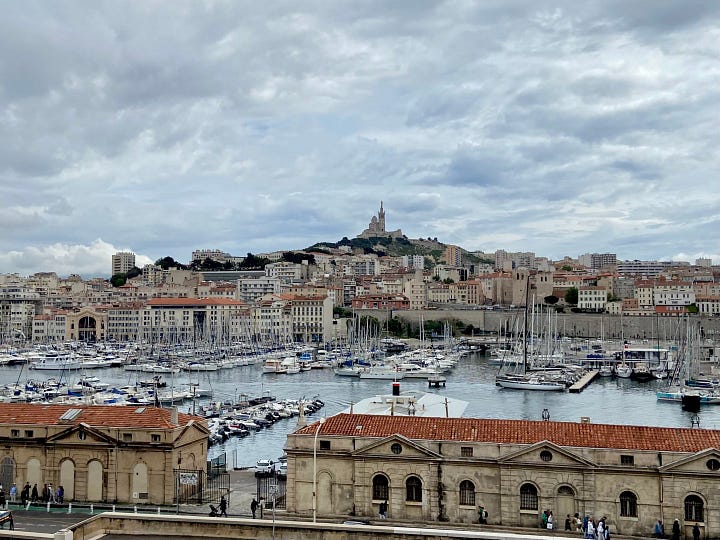

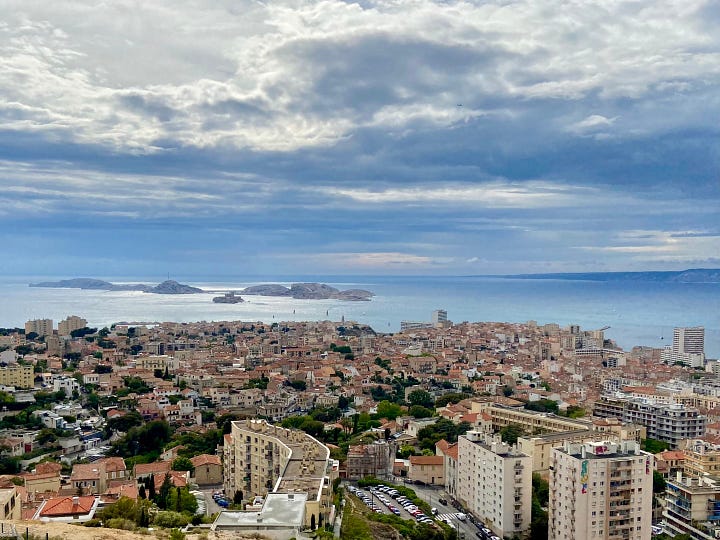
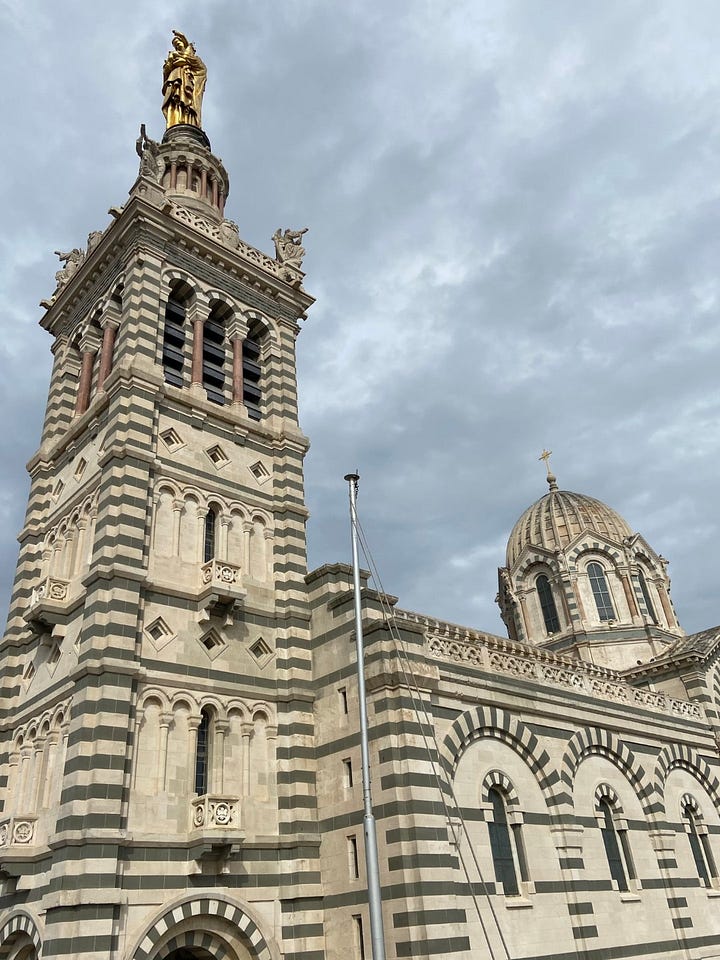
The inside of the basilica was worth the wait for the Ascension Day Mass to finish: richly gilded domes and striped arches set off by midnight blue mosaics and strings of model ships hanging in the aisles and walls crowded with seafaring paintings. The last drawn out chords of the organ finishing the recessional. Jewel-toned votive candles glimmering. A moment of prayer in the crypt chapel.
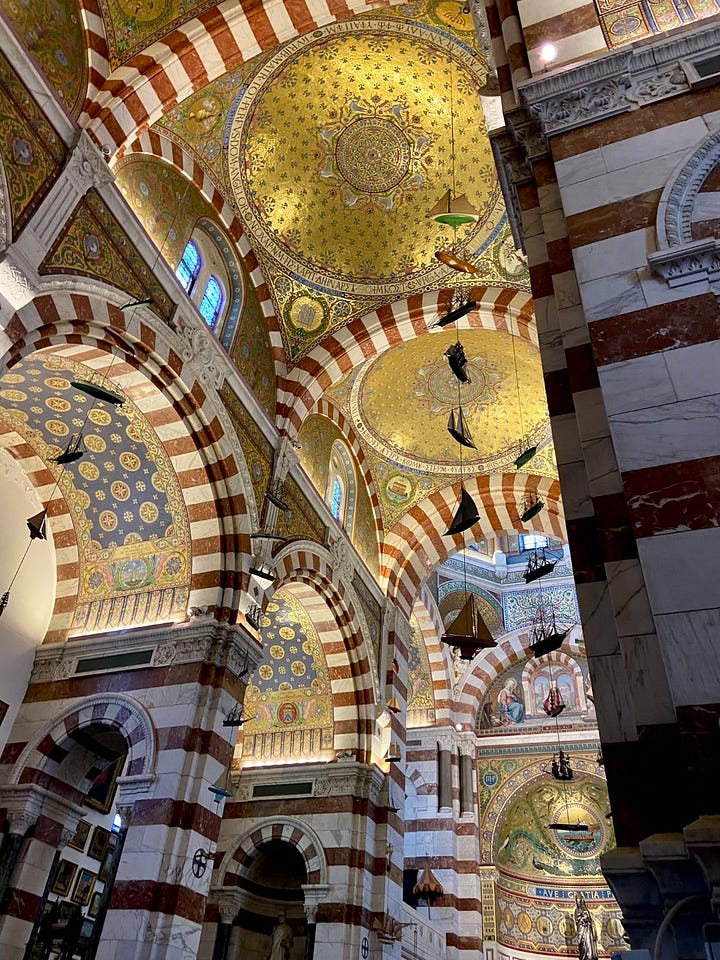
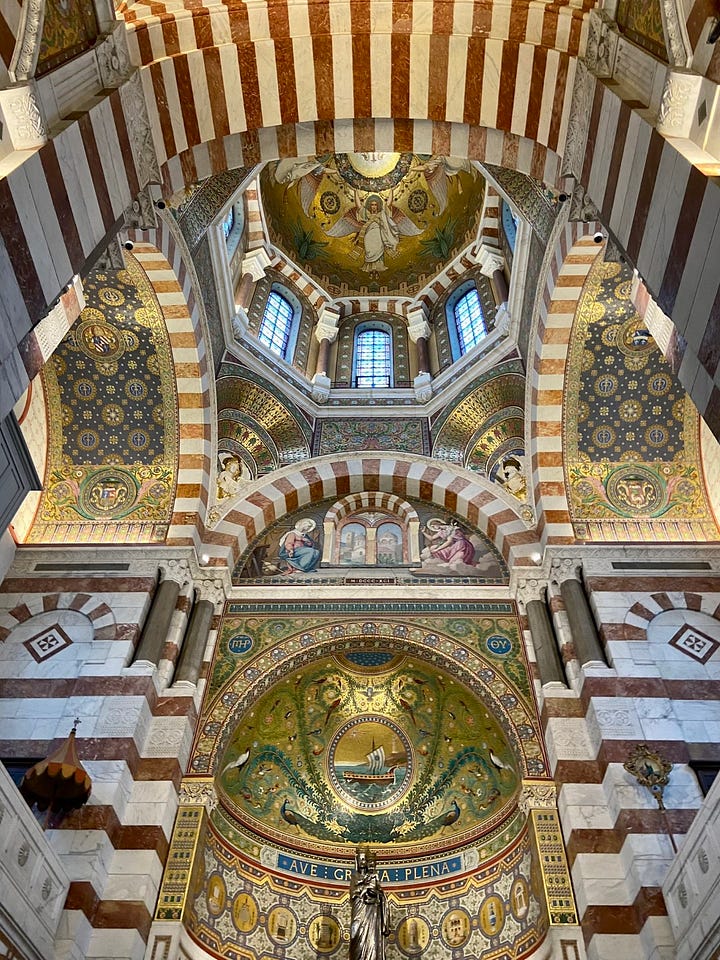
North of the Old Port, Le Panier—the Basket—is a hilly, lived-in maze of narrow old streets that seems torn between tourism and reality. The jumbled street art and graffiti leaps off the walls with an energy that seems to claim ownership and identity, more than to advertise—though it drew me all the same. I roamed the streets where men chatted loudly from rickety tables outside bars or apartments, where potted plants that clearly hadn’t been moved in years spilled off of porches, where tour guides blabbed about how resourceful the Marseillais are, look how they’ve turned old bras into bunting above this street; where café after café put out their menus (Saint-Jacques snackées—seared scallops—are the chef’s specialty, they’re local, try them) and open-air ateliers d’artistes (artist workshops) invite tips. I bought a magnet and tried the scallops2.
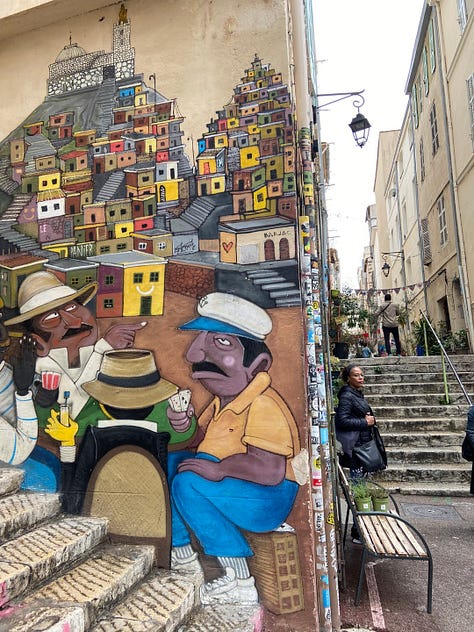
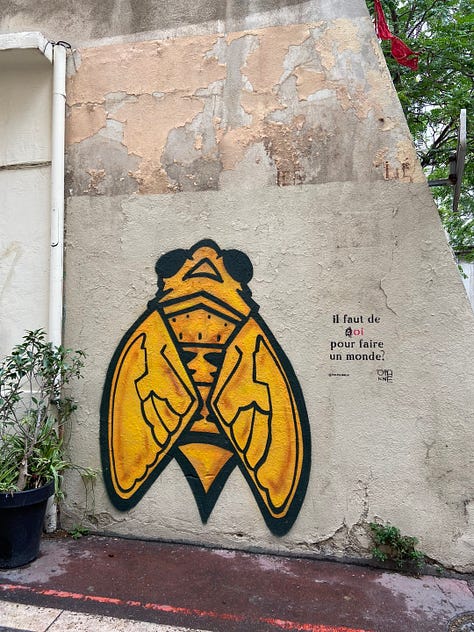
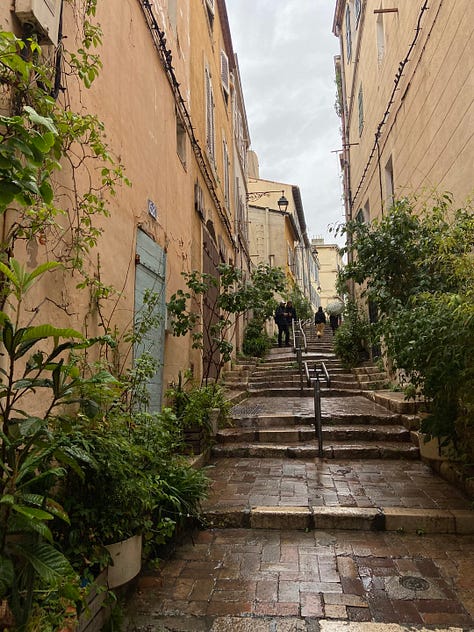
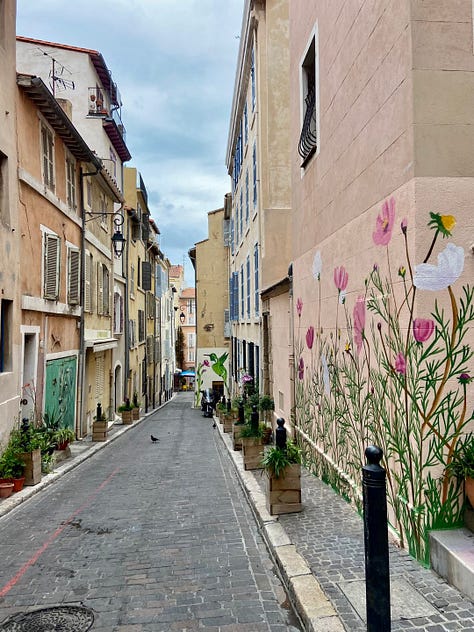
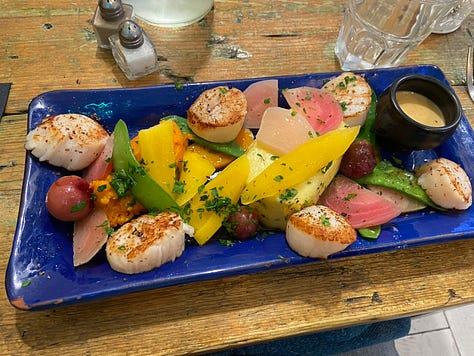
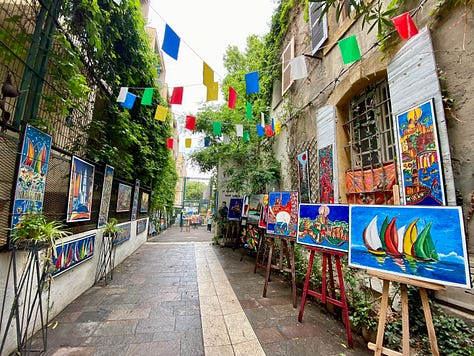
When I told French friends I would be visiting Marseille, I occasionally sensed a bit of side-eye directed at my choice. It’s not the nicest city, people said. Great beaches though, and the Calanques. Avoid the neighborhood east of the train station. Just stick to the touristy areas and you’ll be fine. I walked from the train station coast-ward to my Airbnb in La Joliette, and pondered what to do with my nervousness and aversion to being in this anonymous, run-down urban space that wasn’t marked for me, a solo, middle-class American tourist. In Le Panier, and elsewhere in Marseille, gentrification is both inviting and following visitors like me. But it’s clearly still rough around the edges. What does this transition mean for the people who live there? Do they resent it? Are they being pushed out? I was not there long enough, of course, to have any idea.
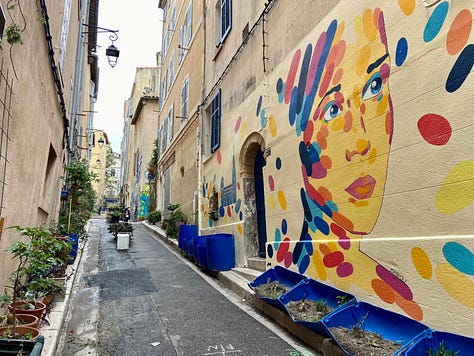
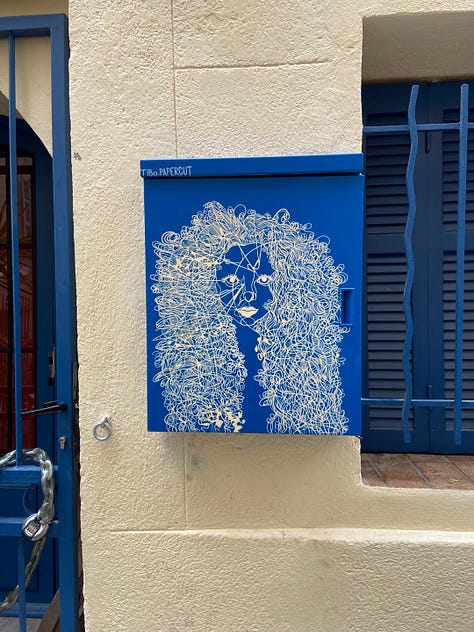
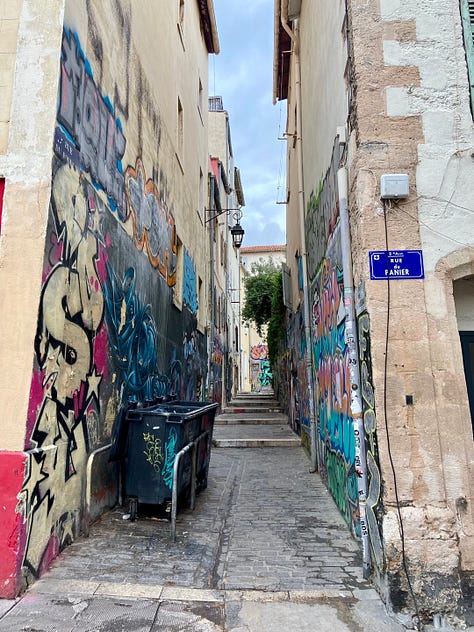

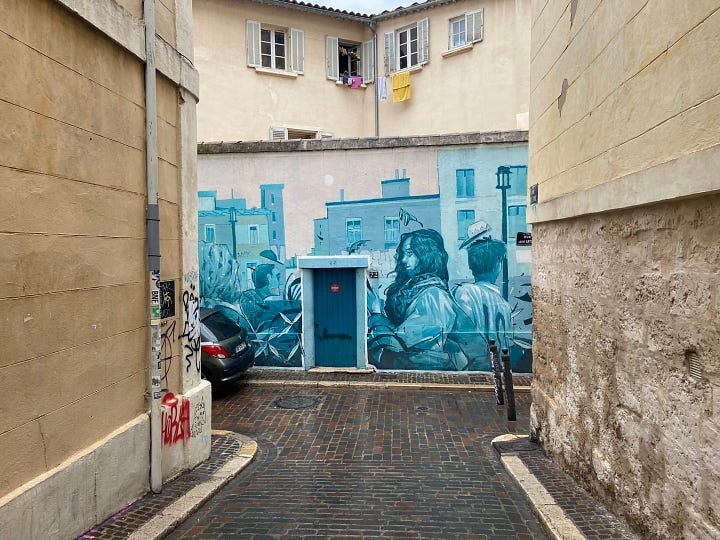
Despite feeling like an outsider to Marseille, however, I could also feel that becoming a French resident has already shifted my center. I’m no longer parachuting into this little pocket of time corralled by long-haul flights in a place with no real overlap with my usual reality. I’m beginning to weave into the context: the geography and the mindset of France, little familiarities like the names of stores and cities and train lines, and of course, the language. I’ve been making progress in my lessons, and when the first few exchanges with waiters went reasonably well, it was a bit of a thrill to compare myself to the tourists around me making do with English—the tourist I had once been. It felt like power. Then I mispronounced bouteille d’eau a couple of times and got English replies from the cashiers, and was finally corrected by one. Messing up such a simple thing was stunningly effective at poking holes, and I deflated quickly. But then I gave myself a pep talk: the French available to the tip of my tongue may be patchy, but there’s more synapses where that came from, and more to come. Plus, I tried. A few months ago I would not have tried. Barriers are coming down. Why put them back up? Onward!
Where Le Panier meets the edge of the city and the sea, the forts begin. There’s Fort Saint-Jean, with square battlements landscaped with Mediterranean plants and open to the public. There, you can walk along the walls to see the Vieux Port, the sea, the other neo-Byzantine church, Cathédrale de la Major, and the other fort across the Port, Fort Saint-Nicholas. And you can take the walkway over the water to the Mucem (Musée des Civilisations de l’Europe et de la Méditerranée), a perfect cube of wavy steel-gray contemporary architecture full of visually striking exhibits about things like how the Mediterranean diet has been commodified and what globalization looked like in Venice and Istanbul in the 16th and 21st centuries. In a dark theater I also discovered an online documentary featuring personal stories of people on subways around the world. Later I looked up the vignettes from Marseille and saw, on the metro line I had just taken that day, a retired dock carpenter who had immigrated from Tunisia in the 1960s and now lived alone in subsidized housing; a girl who had fallen out with her mother and had nowhere permanent to live; and a teenager portrayed as a stylized animated drawing because (it’s implied) he works for a drug dealer and has already served prison sentences, and doesn’t know if he’ll end up dead or permanently in prison if he doesn’t leave Marseille, but he thinks it will be one of the two.
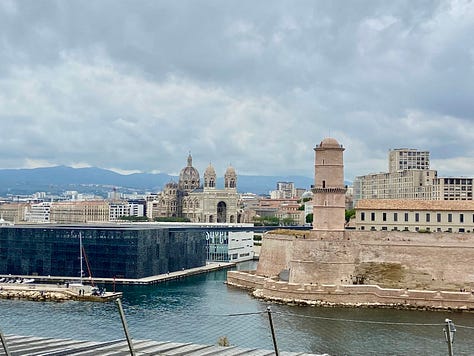
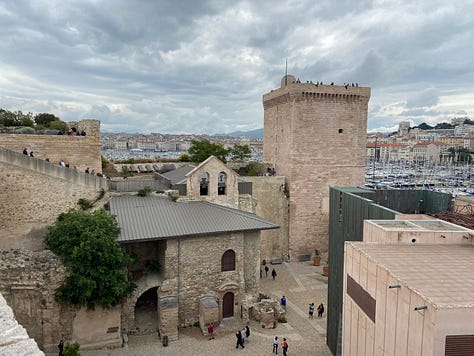
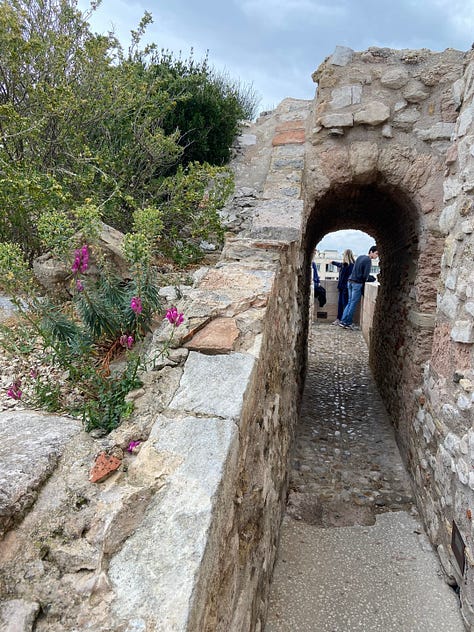
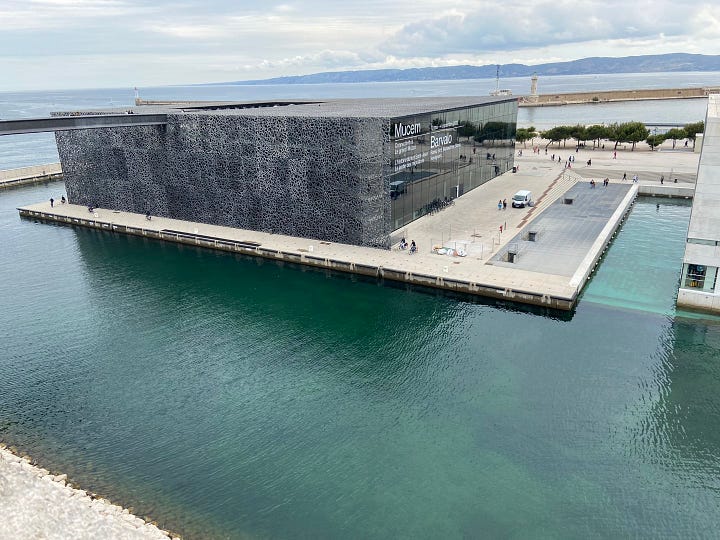

Back to the realm of tourists: it could have been the clouds, but I wasn’t impressed by the Marseille beaches. On my last morning, still laboring under the illusion that to make the trip worth it I had to visit the beaches, I made my way to the largest swathe of beaches I could see on the map: Plages du Prado. In the lowering weather, the beachfront was pretty much deserted except for a couple of food trucks, a copy of Michelangelo’s David, and a handful of locals sitting on the big blocky boulders lining the spits of concrete that protect the sand. The pebbly sand and the concrete and the sky all seemed to be the same semi-industrial genre of gray, and the low hills of lackluster commercial district did nothing to set it off. The water was a nice shade of blue, I’ll give it that. But it all felt too utilitarian. A place to recreate and not much more. Even in good weather, coming here with the crowds just to jostle for a rectangle of sun and sand, to get wet, perhaps to play volleyball, would not be enough to draw me. And let me tell you, the public toilet was grim.
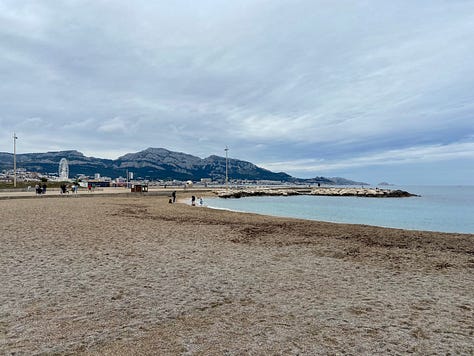
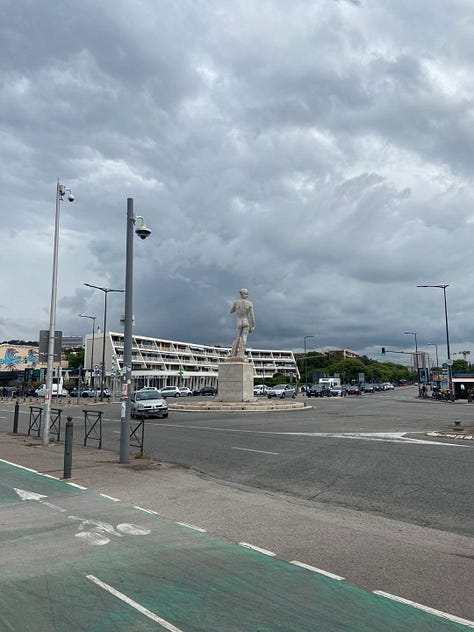
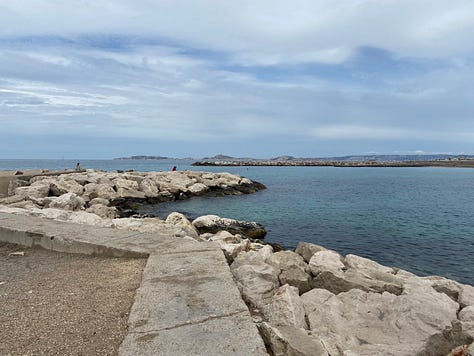
The Calanques were another story. There are half a dozen inlets to hike, all accessible by public transit and none longer than a few hours. After perusing blogs and the Parc National des Calanques webpages,3 I chose the Calanque de Sugiton and took the bus to the university parking lot where the trail started. And this is where I learned to finally love the gray. A companionable number of other hikers, not overcrowded; no sun to “reverberate off the limestone” (as the blog posts repeatedly warn); and only a sprinkling of rain here and there. Even without a blue-sky backdrop, the craggy, swooping white stone and the turquoise inlets in the coves below were stunning. White sails on the water and Mediterranean flora—twisting pines, rosemary, juniper, oak, rock rose—were the perfect garnishes. From the viewpoint, I wound down into the cove, and almost regretted not wearing a swimsuit (I hadn’t even brought one on the trip, so pessimistic was I). Instead I sat on a rock and watched the other young people cavort in the gentle waves while rain spat lightly down. This is how I like my beaches.

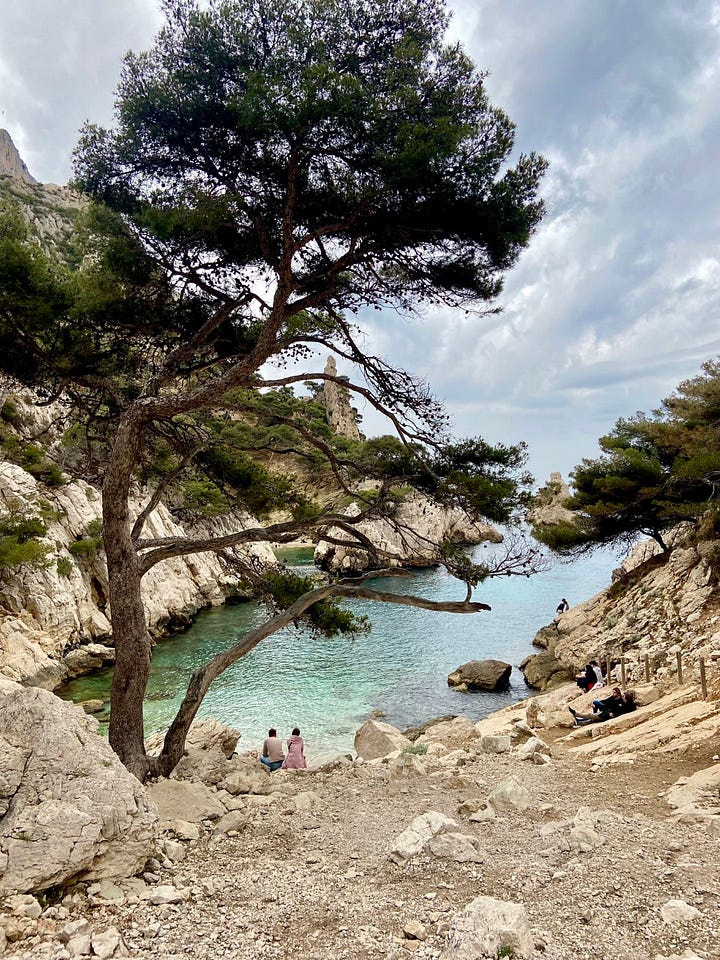
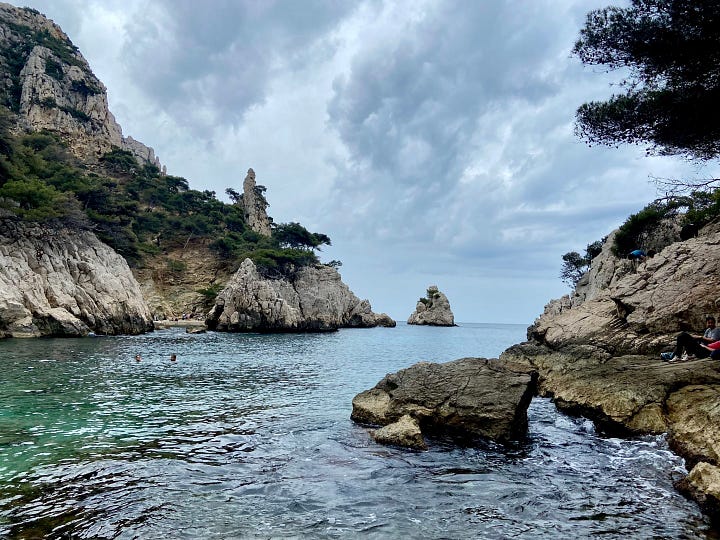
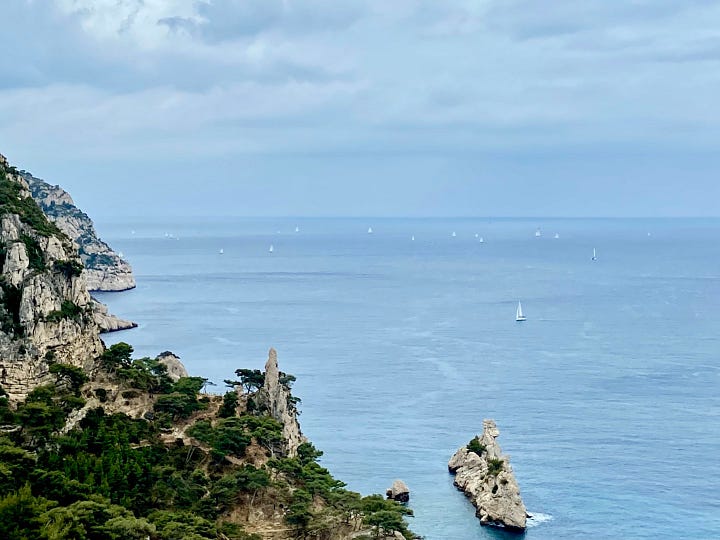
I left Marseille with a blend of gray and color in my head, a panorama of port city painted by immigrants and poissonniers and visitors alike, and a complex underlying reality I can barely begin to grasp. And I have to say, I was happy to see the Alps again. The Alps are where I’m doing the real work of making a new home. So much left to learn.
And meanwhile get made fun of for their accents. I’m still learning to distinguish them.
They weren’t bad for seafood but my stomach wasn’t particularly pleased.
Which sells all the Calanques hard while also pasting warnings about overcrowding in red letters at the top.

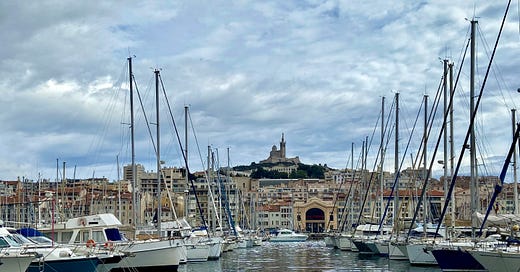



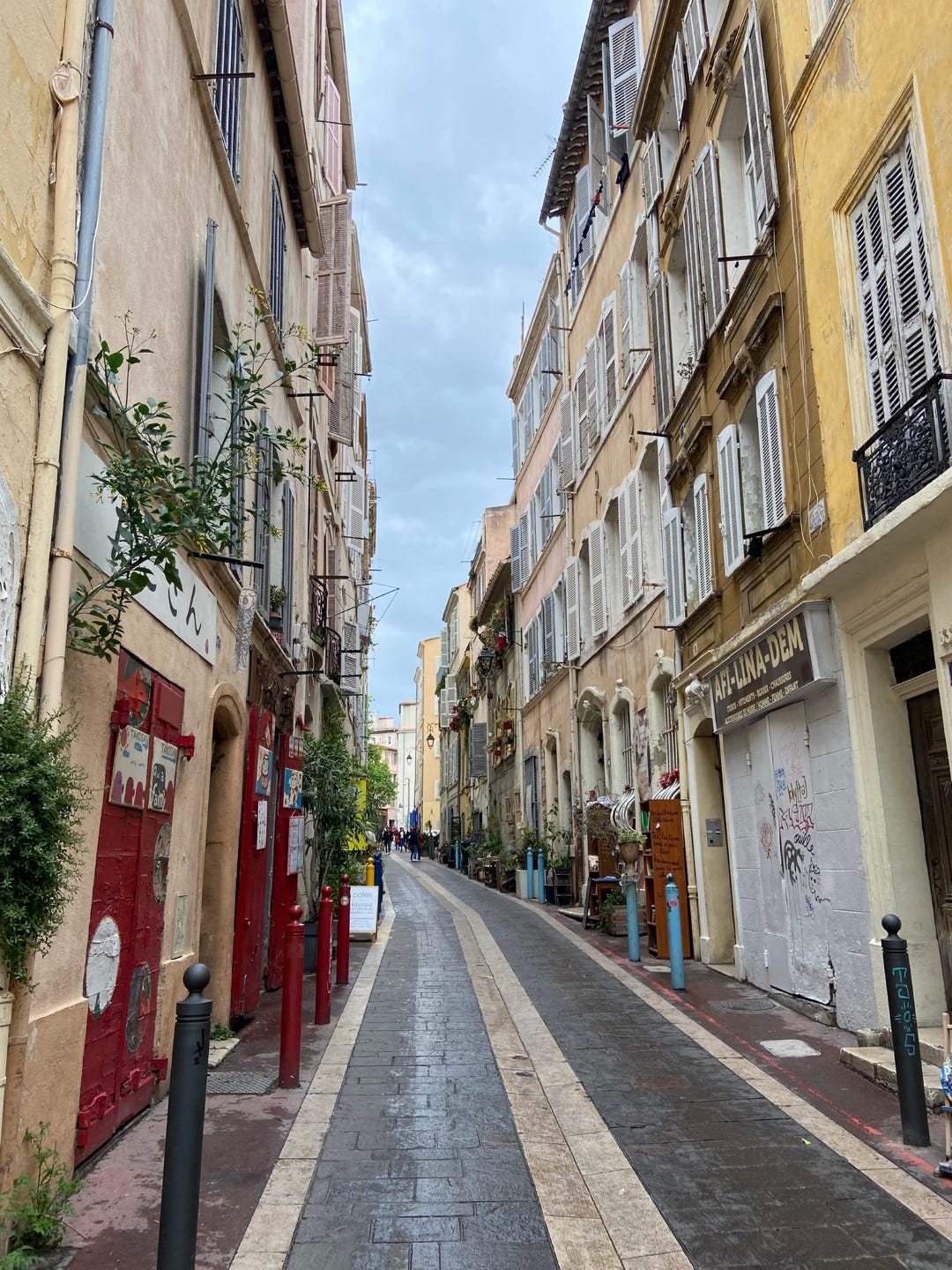
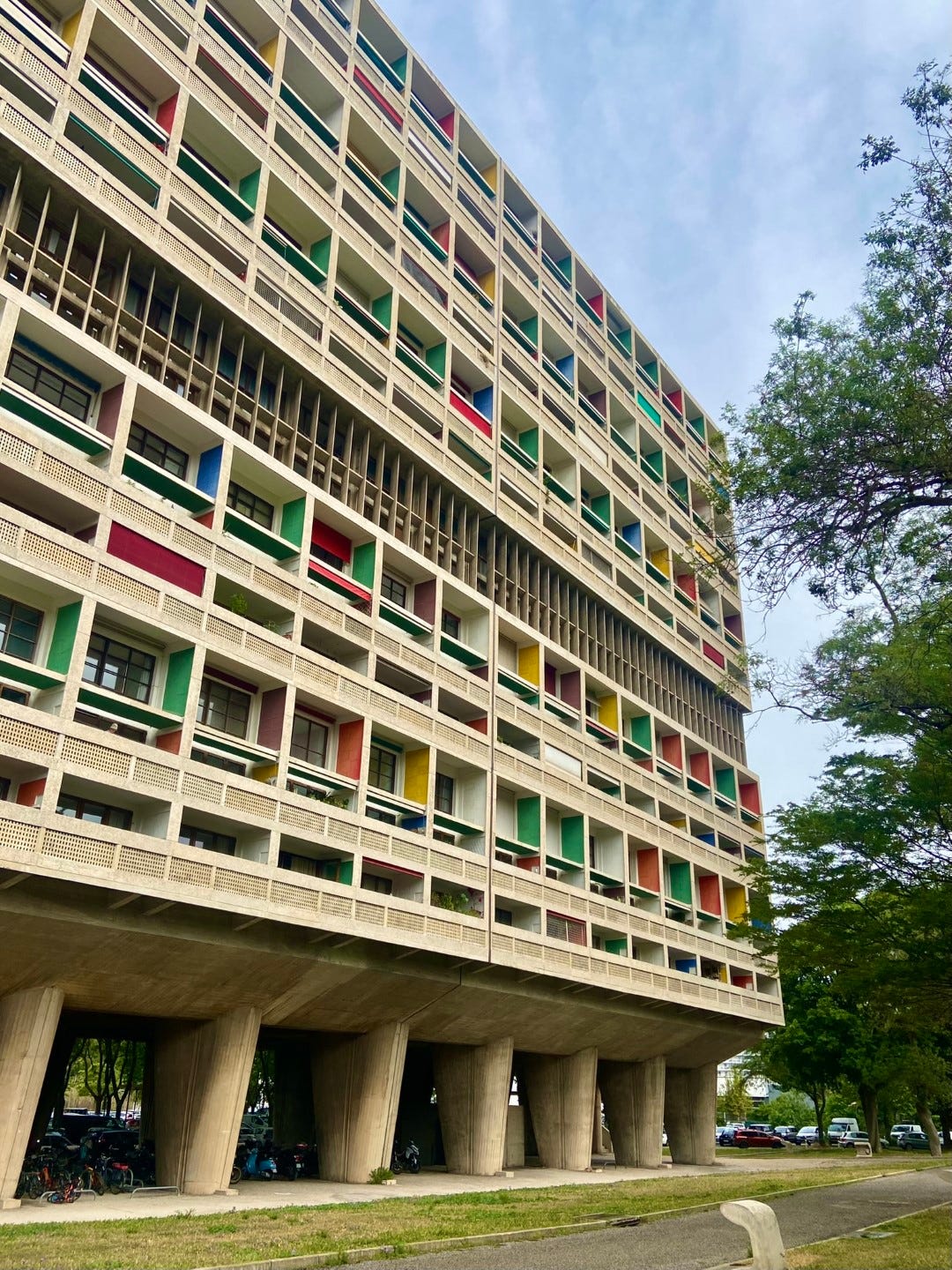
Since you're now a resident, I'm thinking you picked a good place to discover a little bit more of the 'real' France. I love mid-Spring rain, when the earlier chill has moderated (I'm at home this evening with just such a passing thunderstorm happening as I write). And I have to say, I'm glad you have more "synapses" to spare; I think I've seen all I'll ever have/use. You're quite the brave explorer!!
It must be nice to be growing past the tourist phase. Maybe someday I will stay in a place long enough to feel that. And I'm with you on beaches--one of the few things where I prefer beauty to function.